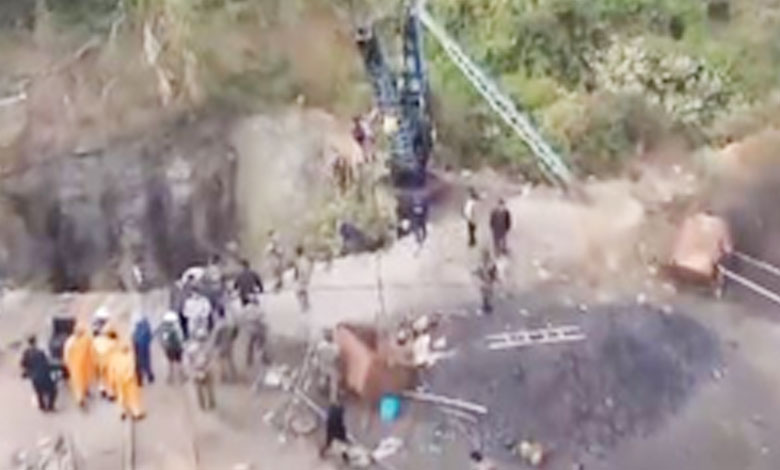Assam Coal Mine Disaster: Navy Divers Continue Search for Trapped Miners in Umrangso
Indian Navy divers continue their search in Assam's Umrangso coal mine for eight trapped miners. With advanced technology and rescue teams in full force, efforts are ongoing to locate the workers and bring them to safety after a tragic mining disaster.

Guwahati: The desperate rescue operations continue at the coal mine in Umrangso, located in Dima Hasao district, Assam, where at least eight miners remain trapped following a tragic disaster.
As of Thursday, specialized Indian Navy divers are spearheading the efforts, working tirelessly to locate and rescue the remaining labourers, officials reported.
Table of Contents
Ongoing Rescue Operations
The Indian Navy’s rescue team, including highly trained divers, resumed operations early Thursday morning, following a thorough inspection of the mine tunnels using Remote Operating Vehicles (ROVs). Despite their best efforts, they have yet to locate any survivors, but the operation remains ongoing.
Harmeet Singh, the Special Director General of Assam Police overseeing the rescue mission, provided an update, stating that while the de-watering of the tunnel was completed, water continued to seep back into the mine from various channels.
This posed a significant challenge, as it complicated efforts to access and clear the trapped miners. To address this, smaller pumps are being used to extract water from the affected tunnels.
Singh emphasized that, despite the ongoing water extraction and the continued use of advanced equipment, the divers have not yet spotted any miners inside the tunnels. The search is now focusing on penetrating deeper into the mine to locate the workers.
The Role of Advanced Technology in the Rescue
The rescue teams have employed state-of-the-art technology, including Remote Operating Vehicles (ROVs), to provide a clearer view of the mine’s depths and structure.
The ROVs, equipped with cameras and sensors, allow rescue personnel to navigate through the challenging terrain of the coal mine without putting additional human lives at risk.
These technological advancements are essential to locate and assess the situation of the trapped miners who are believed to be deep inside the mine.
Fatalities and the Ongoing Efforts
Amidst the ongoing search, the body of one labourer was recovered earlier by the Para divers, as confirmed by Assam’s Chief Minister Himanta Biswa Sarma. The recovery occurred on Wednesday after the 21 Para divers successfully retrieved the body from the mine’s depths. The body was promptly sent to Haflong for post-mortem and will eventually be returned to the grieving family after the formalities are completed.
Expressing condolences, CM Himanta Biswa Sarma tweeted, “Our thoughts and prayers are with the grieving family during this tragic time.”
Additionally, CM Sarma provided assurance that the rescue operation was in full force, with Army and National Disaster Response Force (NDRF) personnel also engaged in the operation. He stressed that the efforts would continue until all possible measures had been exhausted to bring the remaining miners to safety.
Also Read | Fatal Truck-Bus Collision in Tamil Nadu Claims Four Lives, Leaves 30 Injured
The Trapped Miners: Who Are They?
The disaster at the coal mine has affected miners from different regions of India and abroad. Among the nine labourers identified, one is a Nepalese national, another hails from West Bengal, and the rest are from various parts of Assam. The names of the trapped miners are:
- Ganga Bahadur Shreth (Nepal)
- Hussain Ali (Assam)
- Jakir Hussain (Assam)
- Sarpa Barman (Assam)
- Mustafa Seikh (Assam)
- Khusi Mohan Rai (Assam)
- Sanjit Sarkar (Assam)
- Lijan Magar (Assam)
- Sarat Goyary (Assam)
The diversity of the workforce highlights the broader geographical reach of those employed in the coal mines, with workers coming from different states and countries. The tragedy has sent shockwaves through the local communities, and the search for the remaining miners is a race against time.
Past Mining Accidents in Assam: A Lingering Concern
The coal mine disaster in Umrangso is not an isolated incident. Assam has experienced several mining accidents in recent years, often involving illegal mining activities or unsafe work conditions.
The Indian government and state authorities have previously come under scrutiny for not enforcing strict safety protocols at mining sites. This incident brings renewed focus on the safety standards in the state’s mining industry.
The Importance of Safe Mining Practices
The incident in Umrangso underscores the critical importance of stringent safety measures in the mining industry.
Many of the coal mines in Assam operate under hazardous conditions, often with outdated equipment and inadequate safety protocols. As the region’s mining sector continues to grow, both local authorities and mining companies must invest in improving the safety of workers and the conditions of the mines.
The Local Government’s Role in the Rescue
The Assam state government has been actively involved in coordinating the rescue efforts, with Chief Minister Himanta Biswa Sarma personally monitoring the situation.
Alongside the Indian Navy, the Army, and NDRF, the local police force has been working to clear the affected area and support the operation. Authorities have also pledged to provide compensation and support to the families of the trapped miners, with a focus on swift recovery operations.
